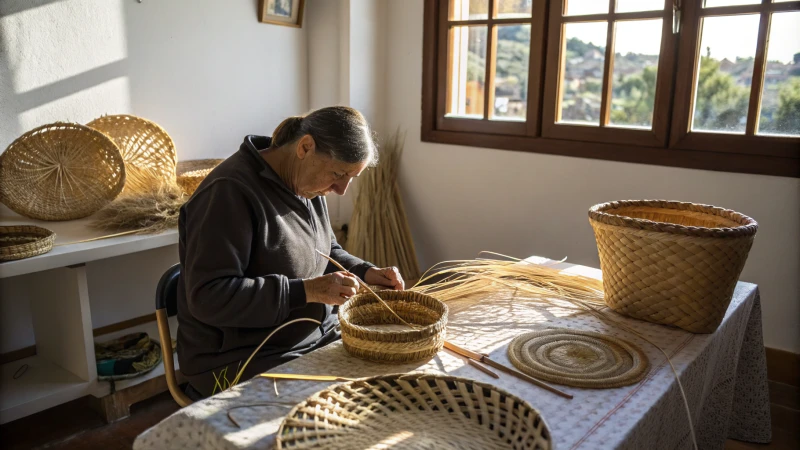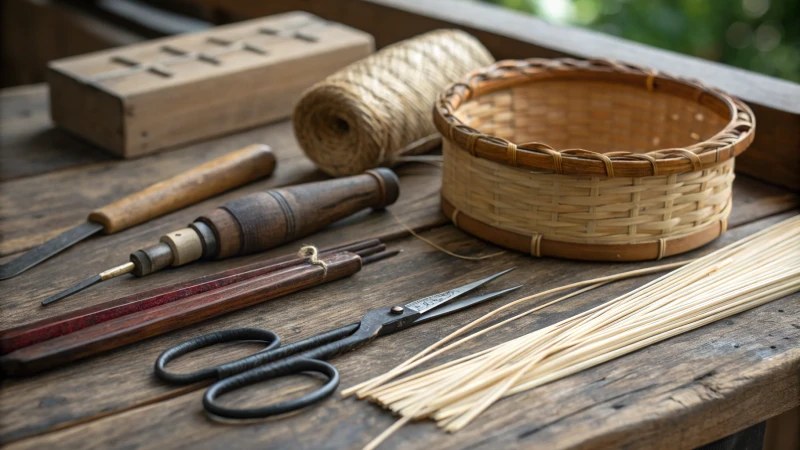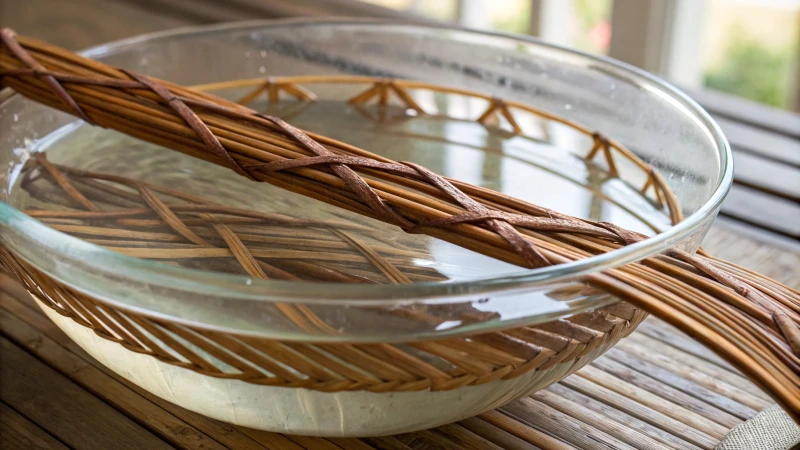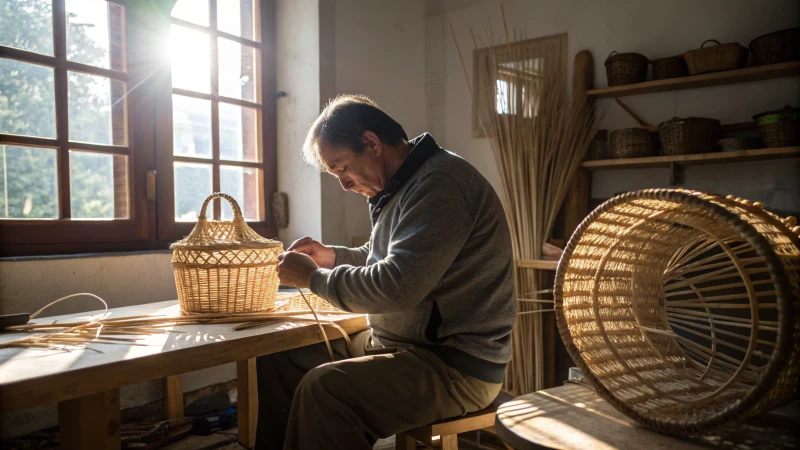
Did you ever feel the satisfying crunch when you weave a basket from rattan? Join me on this adventure. We will explore the wonderful craft of rattan weaving together!
Rattan weaving uses different techniques and preparation steps. These steps help in creating beautiful items like baskets. This blog helps readers choose the right materials. It covers the start of the weaving journey. The blog also guides through the steps for weaving. The crafting journey becomes enjoyable and fulfilling. This is very important.
I remember the first time I tried rattan weaving. My fingers struggled. I felt ready to quit. Then, I noticed the joy in each twist and turn of the material. This activity is not just a craft. It is a way to bond with nature. We create something beautiful through it. I will share important tips, tools and techniques that changed my experience. Each project became not just successful but very rewarding. We will create something beautiful together!
Rattan weaving requires specific preparation techniques.True
Proper preparation techniques are essential for successful rattan weaving, ensuring the materials are ready for crafting.
You can create furniture using rattan weaving techniques.True
Rattan weaving can be used to create various items, including furniture, showcasing its versatility.
What Tools Do You Need for Rattan Weaving?
Did you ever feel the joy of really creating something beautiful with your own hands? You might feel this joy soon. You might be ready to try rattan weaving. I will guide you through the tools needed for this art. These tools turn creative dreams into things you can touch.
To start rattan weaving, you need important tools. You need rattan strips, scissors, an awl, heavy-duty needles, clamps, a tape measure and a sponge. They are crucial for crafting. Use these tools for efficient work. Get high-quality results in your weaving projects.

Essential Rattan Weaving Tools
To successfully weave with rattan, certain tools are essential to enhance both efficiency and quality. Here’s a comprehensive breakdown:
| Tool | Description | Purpose |
|---|---|---|
| Rattan Strips | Flexible strips sourced from rattan palms. | The primary material used for weaving. |
| Scissors | Sharp scissors for cutting rattan strips. | For precise cutting of the rattan. |
| Awl | A pointed tool used for making holes. | Helps in creating holes for weaving. |
| Needles | Heavy-duty needles designed for thick materials. | For stitching rattan strips together. |
| Tape Measure | Flexible measuring tape for accurate sizing. | Ensures pieces are cut to the right length. |
| Clamps | Tools to hold pieces in place while working. | Stabilizes the work for better precision. |
| Sponge | Used to moisten rattan strips for flexibility. | Makes rattan easier to manipulate. |
I began my rattan weaving adventure with great enthusiasm. The right tools turned out to be vital for success and enjoyment. Here’s a list of essentials that I can’t do without.
I recall when I first tried weaving. Rattan strips were in front of me, scissors ready in my hand and excitement filled the air. These tools supported my first creation, allowing me to try different techniques and styles.
Specialty Tools for Advanced Techniques
For those looking to refine their rattan weaving skills or tackle more complex projects, additional tools may be beneficial:
- Bamboo Skewers: Useful for creating intricate designs and patterns.
- Wooden Mallet: Helps in tapping rattan into place without damaging it.
- Weaving Frame: Provides a structure to support larger pieces while weaving.
Investing in these tools can help elevate your craft and result in stunning pieces that stand out.
Where to Find Rattan Weaving Tools
Finding the right tools is crucial for getting started with rattan weaving. Here are some recommended sources:
- Local Craft Stores1 have basic tools you need.
- Online Marketplaces2 like Etsy or Amazon offer many options.
- Specialty Rattan Suppliers3 provide professional-grade materials and tools.
Exploring these options can lead you to quality products that suit your needs and preferences.
Rattan strips are essential for weaving projects.True
Rattan strips serve as the primary material needed to create woven items, making them indispensable in any rattan weaving endeavor.
A wooden mallet is unnecessary for rattan weaving.False
While a wooden mallet can assist in positioning rattan strips, it is not considered essential for basic rattan weaving techniques.
How Do I Prepare Rattan for Weaving?
Getting rattan ready for weaving is not only a part of crafting. It is a journey. This journey connects me to my creative vision. Allow me to guide you through it.
I soak the rattan strips in warm water for 30 minutes to several hours. The strips need this time to become soft and flexible. Soft and flexible rattan is very important for weaving. Soaking helps to reach the right softness. After that, I cut the strips to the needed size. I handle them carefully. Care is important to avoid breaking. Each project requires finding the perfect balance. This balance matters a lot!

Understanding Rattan and Its Characteristics
Rattan always fascinates me. This natural material comes from climbing palms, known for its unique mix of flexibility and strength. I still remember the first time I held a rattan strip; it felt alive in my hands, ready to become something beautiful. Proper preparation is key to unlocking its potential, ensuring it remains pliable during weaving. Soaking, cutting, and conditioning are essential steps that build the excitement of creating something special.
Soaking is a magical moment. Watching the rattan absorb water and swell brings calm and excitement to me. The soaking time depends on the thickness; it might take 30 minutes or several hours. Soaking techniques can vary, so check out our guide on soaking rattan effectively4.
Steps to Prepare Rattan for Weaving
To enjoy a smooth weaving experience, here’s how I prepare rattan:
| Step | Description | Duration |
|---|---|---|
| 1 | Cut rattan into desired lengths using a sharp knife or saw. | N/A |
| 2 | Soak rattan strips in warm water. | 30 min – several hours |
| 3 | Remove from water and let excess water drip off. | 5 min |
| 4 | Begin weaving as per your design. | N/A |
This table provides a quick overview of key actions needed to prepare rattan for any project. If you’d like to improve your cutting skills, read our article on cutting rattan with precision5.
Tips for Handling Rattan Strips
While working with soaked rattan, I learned some best practices:
- Gentle Handling: Treat soaked rattan with care; they are delicate and might tear easily.
- Work in Sections: For longer lengths, cut them into smaller parts; manageable pieces reduce frustration.
- Keep Wet: During breaks, keep rattan moist; this helps it stay flexible and ready.
For more on preserving the flexibility of rattan during weaving, explore our detailed article on maintaining flexibility in rattan6.
Soaking rattan strips is essential for flexibility.True
Soaking rattan in warm water makes it pliable and easier to weave without breaking, ensuring quality results.
Rattan should be cut after soaking for best results.False
Cutting rattan before soaking can lead to difficulty in handling; it’s best done before soaking to ensure proper preparation.
How Can I Boost My Rattan Weaving Skills?
Ready to improve your rattan weaving skills? Dive into some techniques that elevate your abilities. These methods bring joy to your work. They really add fulfillment to the process!
Improve rattan weaving skills by starting with basic techniques. Practice very much with smaller projects. Try different patterns. Ask experienced artisans for help. This approach probably leads to beautiful designs. Craftsmanship really gets better over time.

Understanding the Basics of Rattan Weaving
To enhance your rattan weaving skills, it’s essential to start with the fundamentals. Knowing the various types of rattan and their properties can significantly impact your weaving projects. For instance, some rattan species are more flexible, making them ideal for intricate designs, while others offer sturdiness for structural elements.
Types of Rattan
| Type | Flexibility | Best Use |
|---|---|---|
| Natural Rattan | High | Decorative items |
| Synthetic Rattan | Medium | Outdoor furniture |
| Split Rattan | Low | Structural weaving |
Consider exploring various rattan weaving techniques7 to find what works best for you.
Mastering Weaving Patterns
Once you’re familiar with the types of rattan, the next step is mastering different weaving patterns. Each pattern can add a unique touch to your projects, and learning a variety will increase your versatility as a weaver.
For example:
- Over-Under Weave: This is a fundamental technique that lays the groundwork for more complex designs.
- Twining: Ideal for creating strong and decorative borders, twining involves wrapping one rattan strand around another.
You can find resources on advanced weaving patterns8 to take your skills to the next level.
Practice with Smaller Projects
To build confidence and skill, start with smaller projects before tackling larger ones. Simple items such as coasters or small baskets allow you to practice without feeling overwhelmed. This approach can help you refine your technique and gain practical experience.
Sample Small Projects
| Project Type | Skill Level | Estimated Time |
|---|---|---|
| Coasters | Beginner | 1-2 hours |
| Small Basket | Intermediate | 2-3 hours |
| Decorative Bowl | Advanced | 4-5 hours |
Don’t forget to check out ideas for small rattan projects9 that can enhance your creativity.
Learning from the Experts
Another effective technique to improve your rattan weaving skills is learning from seasoned weavers. Workshops and online courses often provide invaluable insights that self-study cannot match. Connecting with professionals allows you to receive feedback and tips that can significantly enhance your craft.
Many organizations offer rattan weaving workshops10 where you can learn from the best. Consider signing up for one to accelerate your learning curve.
Understanding rattan types improves weaving outcomes.True
Different rattan species have unique properties that influence the quality and style of your weaving projects. Knowing these helps in choosing the right material.
Practicing small projects boosts weaving confidence.True
Starting with smaller items allows beginners to refine their skills without feeling overwhelmed, leading to greater confidence in tackling larger projects.
What Creative Projects Can I Try with Rattan?
Rattan is more than just a material. It is a canvas for my creativity! I have discovered many exciting ways to use it. These uses really elevate my home decor. They also make it feel more personal and welcoming. Here are some of my favorite project ideas!
If you want new ideas for using rattan in your home, try updating furniture, creating wall art, designing lighting and organizing storage. These projects make your space more beautiful and show your creativity. They let you enjoy sustainable design too.

Main Content
I discovered rattan by accident and felt amazed at its versatility. Rattan is like a hidden treasure, ready to be turned into something beautiful. Each project lets me show my personal style. At the same time, these projects are eco-friendly. Take a look at some creative projects I’ve explored. You probably can start your own, too!
1. Rattan Furniture Makeover
Rattan is a versatile material that can bring an elegant touch to furniture. You can transform old furniture pieces by wrapping them with rattan or incorporating rattan elements into new designs. For example, try creating a rattan-wrapped coffee table or refurbishing a chair with rattan accents. This not only enhances the aesthetic but also promotes sustainability by reusing materials.
2. Decorative Wall Art
Why not create stunning wall art using rattan? You can weave rattan strips into geometric patterns or shapes to make unique hanging pieces. These can serve as great focal points in a room. Additionally, consider using rattan for wall decor11 to explore various DIY ideas that integrate this natural material into your home design.
3. Lighting Fixtures
Rattan can also be used to craft beautiful lighting fixtures. Consider making pendant lights or lampshades using rattan strips. Not only will this add warmth to your space, but it will also create interesting shadows and light patterns. Visit DIY rattan lighting projects12 for step-by-step guidance on how to get started.
4. Rattan Planters
For the plant lovers out there, why not create your own rattan planters? These can add a rustic charm to your indoor or outdoor garden. You can easily construct plant pots by weaving rattan around a base or using pre-made rattan baskets as stylish plant holders. This project is perfect for adding a natural touch to your greenery!
5. Rattan Storage Solutions
Create functional yet stylish storage solutions with rattan. Consider crafting baskets or organizers for your living space. Rattan baskets are not only beautiful but also practical, helping keep spaces tidy while adding texture to your decor. Check out creative rattan storage ideas13 for more inspiration.
6. Rattan Headboards
If you’re looking to refresh your bedroom, consider a rattan headboard. You can either build one from scratch using rattan poles or repurpose an existing headboard with rattan details. This addition can enhance the room’s ambiance and provide a cozy feel. Explore DIY rattan headboard tutorials14 for more detailed instructions on this project.
Rattan can enhance the aesthetic of old furniture.True
Transforming old furniture with rattan adds elegance and promotes sustainability by reusing materials.
Rattan is unsuitable for creating lighting fixtures.False
Rattan is ideal for crafting lighting fixtures, adding warmth and unique light patterns to spaces.
Conclusion
Learn the essentials of rattan weaving, including tools, preparation techniques, and creative project ideas for enhancing home decor sustainably.
-
Clicking this link will guide you to trusted suppliers offering a range of weaving tools, perfect for your crafting needs. ↩
-
This link provides detailed reviews on the best tools for rattan weaving, helping you make informed purchasing decisions. ↩
-
Explore this link for a comprehensive guide on how to use each tool effectively in your rattan weaving projects. ↩
-
This link offers step-by-step guidance on soaking rattan effectively, ensuring your materials are ready for weaving. ↩
-
Learn about precise cutting techniques that will enhance your rattan crafting skills. ↩
-
Discover tips on preserving rattan’s pliability during the weaving process for better results. ↩
-
This link leads to expert insights on advanced rattan weaving techniques, perfect for enhancing your skills. ↩
-
Explore innovative patterns that can elevate your rattan weaving projects with this useful resource. ↩
-
Discover small project ideas that can help you practice and refine your rattan weaving skills effectively. ↩
-
Find local workshops or online courses that offer hands-on experience and expert advice on rattan weaving. ↩
-
This link offers a variety of DIY project ideas specifically tailored for using rattan in home decor, perfect for inspiring your next creative venture. ↩
-
Discover unique lighting fixture ideas made from rattan that can transform any space with their charm and warmth. ↩
-
Get inspired by innovative storage solutions using rattan that combine functionality and style for your home organization needs. ↩
-
Learn how to create stunning headboards using rattan, adding a touch of elegance to your bedroom decor. ↩

